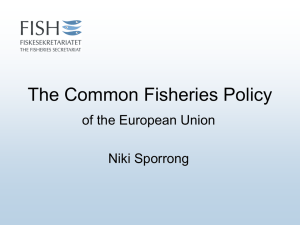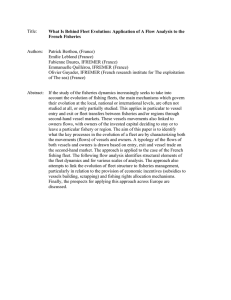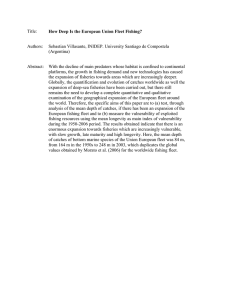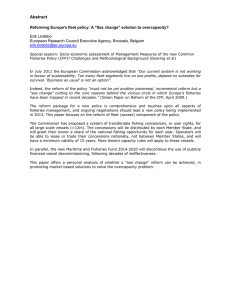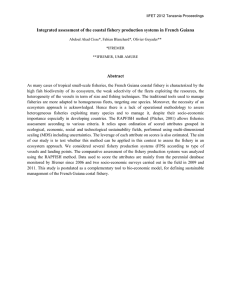NOT TO BE CITED \VITHOUT PRIOR REFERENCE TO THE AUTHORS
advertisement
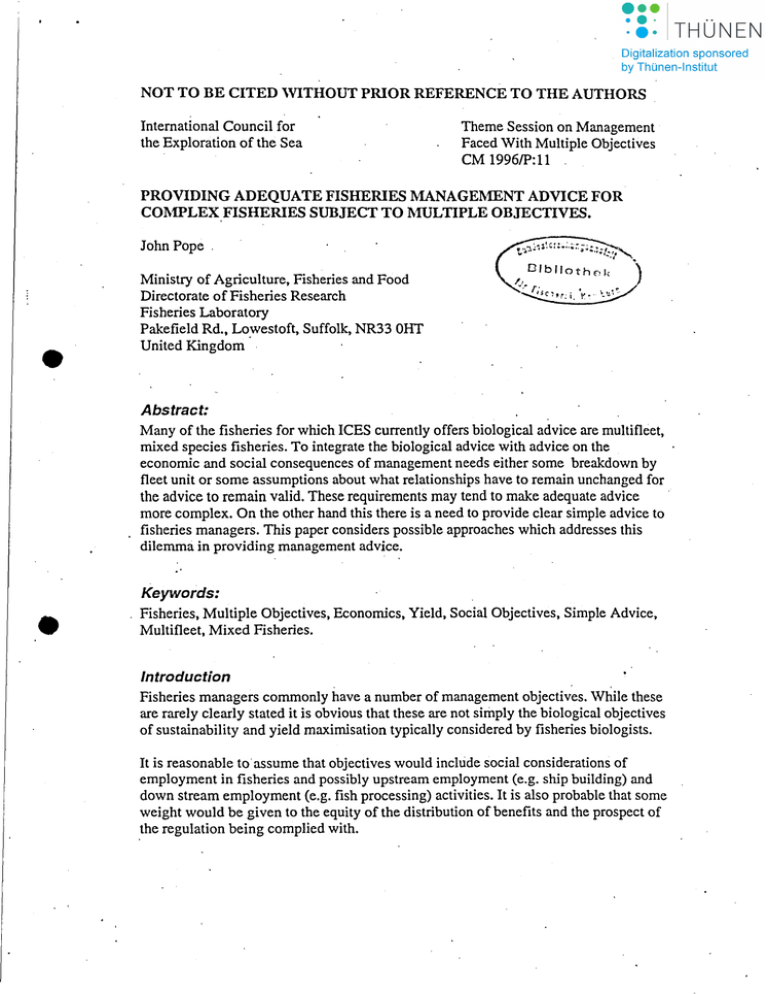
NOT TO BE CITED \VITHOUT PRIOR REFERENCE TO THE AUTHORS International Council for the Exploration of the Sea Theme Session on Management Faced With Multiple Objectives CM 19961P: 11 PROVIDING ADEQUATE FISHERIES MANAGEMENT ADVICE FOR COl\fPLEX FISHERIES SUBJECT TO l\ruLTIPLE OBJECTIVES. lohn Pope. • Ministry of Agriculture, Fisheries and Food Directorate of Fisheries Research Fisheries Laboratory Pakefield Rd., Lo~estoft, Suffolk, NR33 ORT United Kingdom Abstract: Many of the fisheries for which ICES currently offers biological advice are multifleet, mixed species fisheries. To integrate the biological advice with advice on the economic and social consequences of management needs either some breakdown by fleet unit or some assumptions about what relationships have to remain unchanged for the advice to remain valid. These requirements may tend to make adequate advice more complex. On the other hand this there is a need to provide clear simple advice to fisheries managers. This paper considers possible approaches which addresses this dilemma in providing management advice. Keywords: . Fisheries, Multiple Objectives, Economics, Yield, Social Objectives, Simple Advice, Multifleet, Mixed Fisheries. Introduction Fisheries managers commonly have a number of management objectives. \Vhile these are rarely clearly stated it is obvious that these are not simply the biological objectives of sustainability and yield maxirnisation typically considered by fisheries biologists. It is reasonable to assume that objectives would incltide social considerations of employment in fisheries and possibly upstream employment (e.g. ship building) and down stream employment (e.g. fish processing) activities. It is also probable that some weight would be given to the equity of the distribution of benefits and the prospect of the regulation being complied with. It is also reasonable to assume that objectives would contain economic considerations, such as viability, economic rent, return on capital and the cost of enforcement. In recent years cnvironmental factors such as the effect of fishing activitY on non target species havc also necdcd to be considered. Moreover, changes to aH of these factors need to be considered in both the short term and in thc medium to long term. Currently detailcd advice on the consequences of proposed changes only exists for the biological objectives. Clearly there is a need to construct equivalent social and economic advice. Equally clearly the presentation of such advice will be complex. There will thus be a need to find ways to present it which allow fisheries managers to assimilate and integrate the information and to make informed decisions. This paper discusses some simple and less simple approaches to achieving this end. Simple approaches. The STECF of the EU is currently attempting to construct an annual economic report to set along side the annual biological report presented by ACFM (Anon, 1995). This will contain graphs of trends in Capacity (Capital invested, Employment), Activity (Numbers of active vessels, and days at sea), Vessel economic output (Profit, calculated as the ratio ProfitIDay at sea), Fisheries economic output (Gross and net added value). In the first instance these are to be produced for 6 fisheries chosen to span the fishing areas and fleets of most EU member states. These are The Baltic Salmon Fishery. The North Sea Flatfish Fishery. The Dcmcrsal Fishery in the Ccltic Sea. The Demersal Fishery in the Irish Sea. The Demersal Fisbery in the Gulf of Lion and in the Gulf of Genova. The Demersal Fishery in the eastern Mediterranean. As weH as the basic time series information proposed above the reports will also contain, Abrief overview of the current economic state of the fishery. An evaluation of tbe likely evolution of the economic state of the fishery in the short and longer term according to which of the possible management measures are applied. A management advice section, in which the likely economic consequences of a number management options would be assessed. A comments section, in which particular characteristics of the fishery and their relevance to management would be identified (i.e. indicate whether TAC's could be used as control instruments for targeting mixed species. A section on the origin of the data, the quality of the indices of performance and that of the information presented. • Plans are in hand to provide these analyses f~r the auturrin 1996 STECF meeting and assuming this is found feasible and usefu1 the idea could be exterided to other fisheries , and regions. \Vhen these or sirilllar economic reports b"ecome available it will be necessary to think of summarising the results in a way which will help Ministers arid fisheries officials with annual decision making. This is far from an easy task. A major problem is the orthogoniU nature of biological, economic and to some extent socia! advice. Biological advice is necessarily by fish stock, econoinic advice by fleet and socia! advice more related to regions or ports. Clearly, except for the simplest fishery where one stock is fished with orie vessel type from one hilrbour, this requires advice on the effects of the management options by species, by fleet, by country and possibly by port. However, such analyses would typically require model disaggregations that would be beyond the scope of current data sets. Moreover, even if models were available, it is possible that the managers they were meant to serve would not fully understand them or b6 able to use them make the sorts of decisions required. Concerris for the comprehensibility of results niäy argue for a simpler approach where it is assumed that the relative effort of the separate fleets and ports involved in the exploitation of a senes of fish stocks remmned roughly in balance. In practice this conditiori would imply that siInilar management decisions were made for particular groupings of fish stocks, foi' example the North Sea round fish. Giveri this condition it would be possible to give some economic and socia! advice together with the more familiar biological advice. . One approach 'to this might be to present data so thai managers häd to chose one line of a table of options which addressed all the main decision points. This might be useful as it would indicate to fishermeri and to the general public the fuller consequences of a choice. For example that a smaller TAC had been chosen to achieve better long term profitability or that a larger TAC had been chosen despite the risk to sustairiability. ' . Iri the vi<. arid undoubtedly elsewhere, consumer publications and news papers present the results of quite elaborate comparisons of consumer produds in tabular form which present the good and bad features of vanous products with ticks, crosses, star rating etc. It seems at least possible thai such an approach might be used to present options in ways that fisheries managers could simply comprehend. Such infonnation would not all need to be numericaI and indeed likely trends iri värious outcomes might be indicated even if numerica! data were not available. . An exarnple of such adecision table is shown at Table 1. This attempts to show some of the factors which niight have been influenced by the decision of the management regime for North Sea'cod in autumn 1995. It would of course only be valid if equivalent decisions were also made for North Sen haddock arid whiting but at least such a table would indicate to the managers thc severa! consequences of the decision to be made and would indicate to the wodd the factors that had been balanced in the decision amved at. It might be argued thai the necessary condiiion of linkage between the management of stocks exploited by the same fleets, would makecertain of this information redundant or at least repetitive arid so it might be tabulated by fleet elsewhere perhaps in more detail. However there does seem some virtue in presenting all details of adecision iri one simple table. Fleet based approaches Management actions that may have differential effects on different stocks or on different fleet cornponents will require more elaborate models and presentations than those proposed in the previous section. The common currency of such models is usually the age disaggregated fishing mortality that each fleet (and if social considerations are to be addressed possibly each portlsector) imposes on each stock in a fishery. Such information allows the consequences ofmanagement actions at a stock level to be mapped onto each fleet. Hence it allows predictions to be made of the likely changes in catch and in the economic outcome that a fleet is likely to sustain as a result of the measure. Equally it allows the effects of mariagement actions imposed upon each fleet to be assessed in tenns of the consequential effects to the various stocks it harvests and hence to allow calculation of the concomitant changes generated in other fleets. This in turn allows calculation of the economic and biological and possibly some social consequences of various measures. A number of such models exist for the beUer research fisheries of the world. A number of examples were presented to the ICES Multispecies Symposium. Amin. 1989a. and a . biologicalleconomic model was developed by the STCF Sub Group on Improvements of the Exploitation Pattern of the North Sea Fish Stocks. The problem with such models is that they require extensive data sets of disaggregated caich-at-age data as wen as the appropriate biological detail of the stocks and the economic characteristics of the fleets. Such data are often not available. In particular the catch-at-age data is almost invariably collected with coarser disaggregations in mind and extending the level of its disaggregation is equivalent to blowing up a photograph beyond the grain size ofthe film. That is to say the necessary detail cannot be distinguished. In the case of the STCF Working Group model it was attempted to break down catch-at-age data C(s, a, q, f, n, r, y) in to a disaggregation by species s, age a, quarter year q, fleet (Le. gear type) f, nation n,' rectangle rand year y. Since for the North Sea there were about 10 species with an average of about 8 ages for about 5 gear types for 8 countries and about 200 rectangles this amounted to a potential data set of 10*8*5*8*200 = 640000 terms per year. It is true that the disaggregation by rectangle used by the STECF Working Group was a convenience aimed at achieving a data set which could be reaggregated to fonn catch-at-age data for a relatively few large groupings of rectangles. This was done so any closed area could be considered. Thus in practice the actual model might only have to carry, say 6400 tenns, if only two sub areas were considered (e.g. the catch-at-age within a closed region and the catch-at-age without). However, the full disaggregation is obviously required if, for example, the data set is to be able to handle an possible area closures. Thus such a model puts almost impossible strains on existing catch-at-age sampling systems and a future system. designed to achieve such a level of sampling would be several orders of magnitude larger thai1 the existing system and hence prohibitively expensive. • ~ It is interesting to consider whether other, more achievable, approaches to catch-at-age disaggregation might be possible. One approach might be to separate catch-at-age or ' partial fishing mortality into a product of less disaggregated tenns. For exampIe we might write C(s, a, q, f, n, r, y) = N(a, s, q, y)*R%(a, s, r, q)*Q(s, f, q)*E(f, r, q, y)*SEL(s, a, f, q) • Where:N(a, s, q, y) is the riumbers-at-age in the stock by quarter by year (perhaps available from VPA?). ' R%(a, s, r, q) is the proportion of the stock of age a in rectangle by quarter (perhaps available from quarterly grouridfish surveys?) , Q(s~ f, q) is the ~atchability 'of the stock by fleet f by quarter. (this, might be estimated from VPA results? or ifnot directly estimable might be calibrated against aggregate catches?) , ' . E(f, r, q, y) is the fishing effort by fleet by rectangle by quarter by year. (possibly available from fisheries statistics? ) SEL(s, a, f, q) is the selection proportion of age a of the stock by fleet f by quarter (possible available as the result of selection experiments?) It might also be possible to build in discard proportions in a similar fashion. Estimates or guesstimates ofthese muItipIicative factors might be obtained more cost effeciively than a full catch-at-age sampling and allow estimates of partial fishirig mortality F(s, a, q, f, n, r, y) to be estimated as F(s, a, q, f, n, r, y) = F(s, n,~ a, y)*C(s, a, q, f, n, r, y)/Sum of (C(s, a, q, f, n, r, y)) for all f, . These would then fonn the building blocks of modeis designed to estimate'the impact of catch management measures applied to fish stocks on fleet catch and catch rate results and of the impact of technical measures or effort restrictions applied to fleets on fish stocks and on fleet catch and catch rate results. They would also be a necessary but not sufficient requirement for modelling the impact of economic management measures. This would also require knowledge of the behaviour cf fleets under such measures. Presuming that it is possible to construct meaningful fleet stock models using the approach outlined above (or in other ways) the problem remains of how to present the ensuing results to administrators in an understandable fOnTI. \Vhere simple questions are posed or simple "what if' options presented, such as what would be the effect of a . general mesh increase or what effect an overall effort reduction would have, it should be possible to present fleet catch results. These might be presented as aggregate fleet results aIong the lines of the proposed STECF economic report. It might also be worth considering summary international reports and detailed national reports since manägers mightwish to see the consequences to their horne industries in greater detail than those of other countries. \Vhere more complex questions are asked or where "what's best" questions are asked, rather than "what if' questions, then presentation of the results may be less straightforward. A possible approach in this case is to seek for a simple approximation to the results such that control variables can be easily manipulated and preferably such that the simplification has a structure which allows of the analytically investigation of its properties. Such a simplification has two main uses. Firstly it may be used to present the problem to managers in the form of ahands on model which they could manipulate to see the consequences of possible actions. Secondly, it allows objectives to be optimised in an analytical fashion. As an example of this approach a simple multispecies model was presented by the Multispecies Working Group as an approximation to the results of the Multispecies Dynmnic Pool Forecast Model (MFFOR). Anon. 1989 This simulates the effect on long term catch and SSB results consequent on changes in the level of effort of the 7 main fleet groupings in the North Sea. Results are virtually instantaneous and presented as graphs of changes in fleet catch and stock SSB. The model used is Y(Si,jj) == a i,j eEf) + 2:ß i,i,k eEf) eEft all k where a and ß are stock and fleet specific constants and E refers to fleet effort . subscript s refers to stock S, subscript j refers to the fleet in question and subscript k may refer to all fleets. The constants of this model may be estimated from runs of MSFOR where each effort in turn is altered by a small fixed percentage. That is to say by estimating Y(si,j·) Y(si ,jj) at current effort levels and } a a E ft Experience with MSFOR results suggest that this model gives reasonable approximations at least in the direction of effort reduction. Clearly if simple mathematical expressions can be established for the cost of fishing effort and the value of fleet species catch then such a model can also be used to approximate economic results. In fact, with simple linear relationships for these factors it is possible to analytically solve the problem for reference points such as Fmax and Maximum Economic Yield. See for example Anon 1989. • \Ve ure not aware of equivalent approximate models being developed for mesh change. It is interesting to speculate whether a model such as = Y(Si'!j) .. ai,jeEJJ+ L (ß i, j, k • E JJ • EJA +. Ö i, j, k • E JJ • Mesh k + E i, j, k • E JJ • EJA • Mesh k ) all k or some equivalent in transformed variables might approximate to a multifleet multispeci(~s model. Such an approach would obviously need at least a factorial experiment on MSFOR for changes in each fleets effort and mesh to estimate all the constants. • , . Assuming this or some other model could provide reasonable approximations to the more complex dynamic pool prediction model then it should prove useful in exploring the multidimensional multispecies yield isopleth diagram and hence of providing indications of where various objectives might be maximised subject to constraints on other objectives. . Such simplified models might be a good basis for collaboration between biologists, economists and sociologists. Clarity in advice \Vhat ever model of complex multispecies, multifleet, multiarea fisheries is adopted it will be of little use in the real word unless its results can be presented to the managers in as clear and unambiguous fashion as possible. This remains the most challenging problem. It is difficult for administrators to cope with options because each option is likely to favour particular countries, regions and fleets more than others. The complex multidimensional options likely to be presented when multispeeies, multifleet, multinational are addressed are thus likely to cause administrators corisiderable problems. One solutions to this problem would be, to esta~lish by dialogue the objectives and constraints that administrators hold. Specialists could then seek narrow . ranges of specific solutions that optimise managers objectives subject to their constraints or, more realistically, which optimise objectives subject to as few constraints being violated as possible. An alternative approach, where the group of managers is small and have reasonably coherent objectives would be to present them with a relatively simple interactive model which they could eJ.Cplore to find their own preferred solutioris. The likely success of either of these approaches is likely to be enhance if results are limited to those of direct relevance to the decision makers and if they can be viewed in the context of historic time series of the variables. Administrators may thus wish to be presented with results such as the risk to the viability of fish stocks, the value and profitability of specific fleets aggregate catches and the li~ely regional impacts of various measures. They would wish to eompare these with historie series of such results for stocks, fleets and social groups of inte!est. They might wish to see options I ----~--- chosen to improve such results in the medium term subject to constraint on short term losses and on equity. Conclusions To be useful to managers quantitative or at least qualitative advice needs to be presented on the consequence of particular management options to relevant social, economie and biological faetors. Beyond models appropriate to simple fisheries this requires joint models whieh disaggregate the data such that the separate consequenees to fish stocks, fishing fleets and regions and social groups can be considered. Under most existing approaches this may make unrealistic demands for data. Consequently an approach which may be less exacting is proposed. Complex models are difficult to present quiekly and simply and some simple approximation to the more complex models are discussed. It is, however, noted that to be useful for fisheries management, an absolute requirement for these or other models is the maximum clarity and the minimum of ambiguity. References Anon., 1989, Report ofthe Multispecies Assessment Working Group, Copenhagen, 716 lune 1989. ICES CM.1989/Assess:20 Anon. 1995, 2nd Report ofthe Scientifie, Teehnical and Economieal Committee for Fisheries, EU Commission 6 November 1995. Daan, N. and Sissenwine, M. P. (ed.), 1989, Multispecies Models Relevant to Management ofLiving Resourees. ICES mar. Sei. Symp., 193: 358p. • • • !!! -i '" ;"0, 0 ~ ~ ~ ~ ~ ~~ CD 0> ... ~ 'J''J' '" "'~ .... ~CD Ne:, '" 1.0, ~ CD 0> ... ~ 'J' 'J' ~ CD 0> 'J''J' ~~ '" .... ... ....'" ~ ~ ~ ~CD "'~ ~CD 00 00 00 ~ ~ "' ... ... '" "'''' " ' 0 CD .... "''J' 'J'O> CD CD lDlD ~ lD "'''' NO CD .... "''J' ... '" "'''' CD 'J'''' CD ~lD lD lD ~ .... '" Ir ::-+ -+ l' "'''' I:I! I-JI-J I' I' ~ [tl! ~~ Itl! I~ I' ~-+ -+ I: tl;t- ~I-J I-J 1:11 1+ ' 1+ ' It I: t;. x ~~ ~~ X lC ~~ Average catch 1985-94 SSB as % MBAL in midtenn SSB In 1994 x ....01 o Yield in Medium tenn ::J -+- CD ce Yield next year '"0... Current Fishing IFmax ~ Employment in midtenn ~ '" Current FIshing IFmed SSBIR as % of Unfished Profit next year '" CD 0. ::r o o· CD -+- Ol er g; Current SSB as % of MBAL 0> ö1 -+- o Employment next year Midtenn SSB as % 01 MBAL z ;>; ACFM Prefered Option Discarded % by weight ~ Discarded % by number STECF Prefered Option x x X lC X lC ::J Average SSB 1985-94 '"in.... .. .. 3 'U CD Ol Profit In midlenn XX ~ Catch in 1994 SSB as % MBAL 1997 .... .... t- Relative to Fmed CD 0> I:I! ~ ß TAC 1994 lD~ ~ .... ~ t' 0> ... ~ CD ~~ ~ Fishing level change m >< Ol ~ ~ lD~ CD ..... ~ ~ TAC 1995 "'~ Nt., .km '" Options Catch 1996 ~ 00 00 00 ~ er Cli 00 00 00 ~ n;l > Ö ::1 Ne:, . 1 CD o ..... o o 0. ::J cn C er Prospect of Complience Missreporting % in 1994 » CD Ol < ......... Z o ::1- ::r cn -CD Ol
